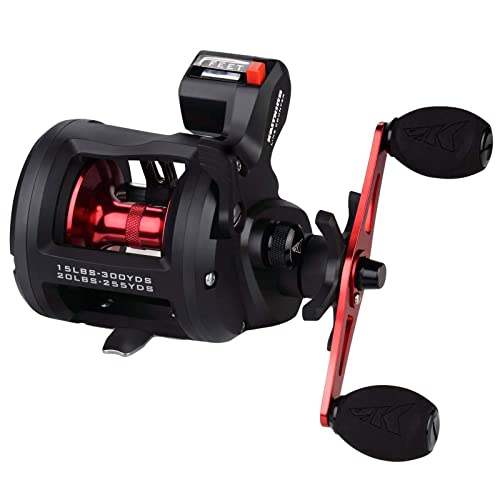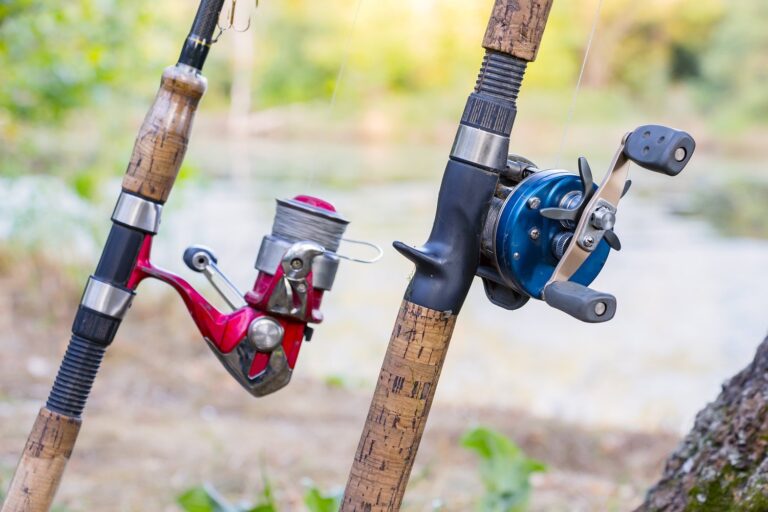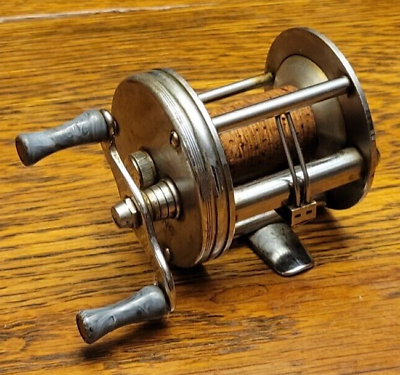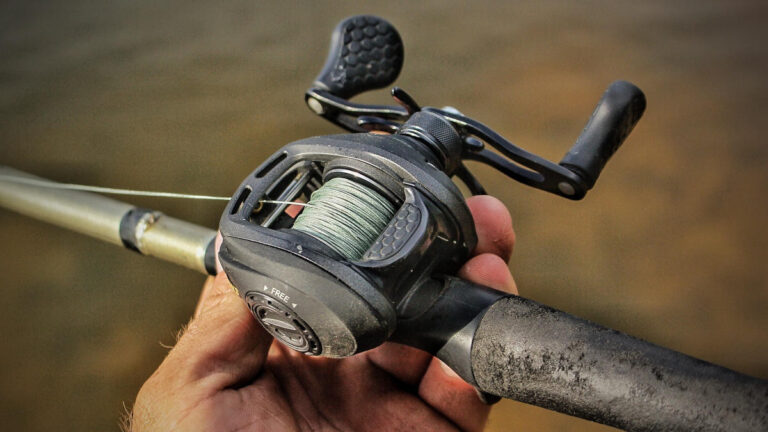Baitcasting reels are designed for experienced anglers who demand accuracy and control. Features such as gear ratio, brake system, spool tension, and bearing systems are essential for successful and enjoyable fishing experiences.
Baitcasting reels are a popular tool among experienced anglers who are looking for accuracy, control, and a more natural fishing experience. With a baitcasting reel, it is possible to cast further and more accurately than with a spinning reel, and it provides more control over the placement and speed of the lure.
However, choosing the right baitcasting reel can be overwhelming, as there are many features to consider. The gear ratio, brake system, spool tension, and bearing systems are all important factors to take into account when selecting a baitcasting reel. In this article, we will discuss these features in detail to help you make an informed choice.

Credit: gearknacks.com
Feature 1 – Gear Ratio
Baitcasting Reel Features: Feature 1 – Gear Ratio
If you’re an angler in search of a baitcasting reel, there are some essential features to look for. One of the most crucial elements to consider is the gear ratio. In this section, we’ll take a closer look at what the gear ratio is, how it affects your fishing experience, and why it’s essential to select the right gear ratio for the type of fishing you’re doing.
Explanation Of Gear Ratio And How It Affects Speed, Power, And Control
The gear ratio defines the number of times the spool rotates with respect to the handle’s complete turn. It determines how quickly the line is retrieved after casting. Here are a few key points to keep in mind that will help you understand the gear ratio better:
- A low gear ratio (below 6: 1) offers more torque allowing you to cast heavier lures, and it is great for fishing for larger species such as bass and musky. It retrieves lines slower, providing more cranking power
- A high gear ratio (above 7: 1) retrieves line faster, making it great for catching smaller species like trout or when you need to catch fish quickly in a tournament setting
- Mid-range ratios (between 6: 1 and 7:1) are a good all-purpose choice. This gear ratio allows for a reasonable retrieval rate while providing ample cranking power for pulling in bigger fish.
Importance Of Selecting A Baitcasting Reel With The Appropriate Gear Ratio For The Desired Application
Picking the right gear ratio is essential. Here are a few reasons why:
- Choosing the wrong gear ratio will impact your fishing experience. Suppose you’re using a gear ratio that retrieves too slowly, and you’re fishing for smaller species that require quick reel in. In that case, you’ll find yourself struggling to reel in your catch. Conversely, if you’re using a high gear ratio that retrieves too quickly, you may struggle with heavier lures or larger species that require a slower, more powerful retrieve.
- Picking the perfect gear ratio gives you more control and accuracy. With a suitable gear ratio, you can cast lures at the exact angle you need, accelerating or staying with the right speed to get it to the fish’s favorite spot. The more control you have, the greater the chance you’ll get a bite.
- The right gear ratio will give you better results, helping you to catch the fish you’re targeting, and avoiding missed bites or lost fish.
When choosing a baitcasting reel, it’s crucial to assess the gear ratio and ask yourself if it fits your specific needs and circumstances. Take your time to research, read reviews, and prioritize your area of fishing. Doing so will help you become a better angler and enhance your fishing experience.
Feature 2 – Braking System
Overview Of Braking Systems And Their Importance In Controlling The Amount Of Line Released During Casting
Baitcasting reels have a braking system that helps control the amount of line released during casting. This feature is essential to prevent backlashes, which happens when the spool spins faster than the line left the baitcasting reel. The braking system helps decelerate the spool so it doesn’t spin too fast, giving you more control and accuracy during casting.
Explanation Of The Different Types Of Braking Systems And Their Advantages And Disadvantages
There are two types of braking systems in baitcasting reels:
- Centrifugal braking system: This braking system uses centrifugal force to control the spool’s speed during casting. The pins on the side plate push against the brake ring when the spool’s speed increases, slowing down the spool’s rotation. Here are the advantages and disadvantages of this braking system.
- Advantages: It allows for more control over the spool’s speed during casting, reducing the likelihood of backlashes. It’s more applicable to casting heavier baits that require more power to avoid backlash.
- Disadvantages: It’s less efficient in handling lighter baits or when the casting distance varies. It requires manual adjustments to the side plate’s pins to achieve the optimal braking force.
- Magnetic braking system: This braking system uses magnets to slow down the spool’s rotation during casting. It controls the spool’s speed by adjusting the magnetic field near the spool. Here are its advantages and disadvantages:
- Advantages: It’s more versatile and can handle a wide range of baits and casting distances with minimal adjustments. It provides better accuracy and distance control during casting.
- Disadvantages: It’s less useful in controlling the spool’s speed while casting heavy baits because it’s more reliant on the magnetic field’s force. The spool’s slowing power is less predictable, requiring some experience to determine the optimal braking force.
Each braking system has its advantages and disadvantages, and it’s up to the angler’s preferences and intended fishing scenarios to consider which one best suits them. Centrifugal braking systems are more reliable when casting heavier baits, while magnetic braking systems provide better control over casting distances.
Feature 3 – Spool Size
Discussion Of Spool Size And How It Affects The Amount Of Line That Can Be Retrieved With One Turn Of The Handle
Spool size is one of the most critical factors to consider when selecting a baitcasting reel. It plays a vital role in determining the number of lines a reel can retrieve with one turn of the handle. This factor affects the performance and speed of the reel.
Here are key points to remember:
- A large spool retrieves more lines than a small one. It’s important to consider the spool size based on the fishing application you’re using.
- A larger spool is suitable for fishing in deep water or when targeting species that require more line.
- However, if you’re fishing in shallow waters or aiming for small fish, a smaller spool would suffice.
- Keep in mind that the spool size determines the maximum line capacity of your reel. You don’t want to end up with a spool that can’t hold enough line for your fishing needs.
- While larger spools can retrieve more lines at once, they’re usually slower than smaller spools.
Importance Of Selecting The Right Spool Size Based On The Fishing Application
Choosing the appropriate spool size is vital to optimize your fishing experience. Here are key points to consider when selecting the spool size based on your fishing application:
- If you’re targeting large species, you need more line capacity. A larger spool can hold more line, allowing you to reel in your catch with ease.
- If you’re fishing in heavy cover areas, where there are a lot of chances the fish might snag your line, selecting an appropriate spool size is essential.
- A smaller spool size is suitable for short casting distances. This type of reel is ideal for fishing in shallow waters or catching small fish.
- Smaller reels will also be a better fit for anglers who prefer lightweight equipment.
Spool size is an essential factor to consider when looking for the perfect baitcasting reel. A correct spool size selection can significantly improve your succesful fish catching with the right balance of casting distance, line capacity, and ease of use.
Feature 4 – Drag System
Baitcasting Reel Features
Fishing is a popular outdoor activity that requires the right gear to make a successful catch. One of the most essential tools for anglers is the baitcasting reel, a device that helps catch fish. The drag system is a crucial feature of baitcasting reels that affects the ability to land fish.
In this blog post, we will explore the different types of drag systems, their advantages and disadvantages, and how they can enhance your fishing experience.
Definition Of Drag System And How It Affects The Ability To Land Fish
The drag system is a mechanism that controls the rotation of the spool, which determines the amount of tension on the fishing line. When a fish is hooked, it exerts force on the line, which can cause it to snap if there is too much tension.
A properly adjusted drag system prevents this by allowing the fish to pull the line without breaking it. The drag system also helps tire out the fish, making it easier to reel in.
Having a consistently adjustable drag system can enhance your baitcasting reel’s ability to land fish. You should set your drag system slightly lower than the line’s breaking strength to provide enough resistance to tire out the fish without the line snapping.
Explanation Of The Different Types Of Drag Systems And Their Advantages And Disadvantages
Baitcasting reels come with two primary drag systems: star drag system and magnetic drag system.
- Star drag system: This system is manually adjustable and uses a star-shaped wheel to regulate spool resistance. It allows anglers to adjust the drag according to their preference and fishing conditions.
Advantages:
- Allows a precise adjustment of drag
- Offers a high degree of control for experienced anglers
Disadvantages:
- Adjusting the drag can be time-consuming.
- A poorly adjusted star drag system can create too much slack in the fishing line, reducing sensitivity and affecting the ability to make accurate casts.
- Magnetic drag system: This system uses magnetic resistance to control the spool speed. It works by slowing down the spool when the magnetic field interacts with its metallic parts.
Advantages:
- Easy to adjust
- Requires less maintenance than a star drag system
Disadvantages:
- Not as precise as the star drag system
- Unsuitable for heavy lures or windy conditions
Choosing the right drag system for your baitcasting reel is fundamental to maximize the catch rate and efficiency of fishing per trip. Both the star drag system and magnetic drag system have their advantages and disadvantages. It is crucial to understand the different types of drag systems before making an informed choice to perfect your fishing experience.
Feature 5 – Ball Bearings
Baitcasting Reel Features – Feature 5: Ball Bearings
When it comes to selecting the right baitcasting reel, one of the most critical features to consider is the number and quality of ball bearings that the reel has. Ball bearings play a crucial role in determining the reel’s smoothness, durability, and overall performance.
In this section, we will discuss the importance of this feature and how it affects the reel’s performance.
Explanation Of Ball Bearings And How They Affect The Smoothness And Durability Of The Reel
Ball bearings are small metal balls housed in the reel’s body, spool, and handle that reduce friction and enable the parts to spin smoothly. The more ball bearings a reel has, the smoother it will operate, and the more comfortable it will be to cast and retrieve.
High-quality ball bearings also help extend the reel’s lifespan by withstanding abrasion and reducing wear and tear. Moreover, they also provide more accurate and consistent casts, even in adverse weather conditions.
Importance Of Selecting A Baitcasting Reel With High-Quality Ball Bearings
Selecting a baitcasting reel with high-quality ball bearings is essential to ensure that you have the best possible fishing experience. High-quality ball bearings reduce the amount of friction that occurs within the reel, making the operation much smoother and quieter.
This translates to longer casts, greater accuracy, and less effort required when retrieving.
Additionally, high-quality ball bearings are more durable, meaning that they will last longer and require less maintenance. They can withstand harsh conditions, such as saltwater exposure and heavy use, without affecting the reel’s performance. Investing in a baitcasting reel with high-quality ball bearings is a smart move for any angler looking for a reliable and long-lasting fishing companion.
The number and quality of ball bearings in a baitcasting reel are crucial factors that determine its performance, durability, and overall value. Look for high-quality ball bearings in your next baitcasting reel purchase. This will ensure a smoother casting and retrieval experience, greatly improving your chances of bringing home your next trophy fish.
Feature 6 – Handle Material
Overview Of Different Handle Materials And How They Affect Grip, Comfort, And Durability
The handle material of a baitcasting reel plays a crucial role in determining its overall performance. When selecting a baitcasting reel, you need to consider the handle’s material, as it can significantly affect your grip, comfort, and durability. Here are some of the most commonly used handle materials and their pros and cons:
- Aluminum: Aluminum handles are lightweight and durable, making them an excellent choice for anglers who fish for extended periods. However, aluminum handles can be quite slippery, especially when wet, and can cause hand fatigue over time.
- Eva foam: Eva foam handles are comfortable to grip, provide good traction, and are relatively inexpensive. However, they are not as durable as other materials and can deteriorate quickly with frequent use.
- Cork: Cork handles offer a comfortable and non-slip grip, making them a popular choice among anglers. They are also lightweight and have excellent shock-absorbing properties. However, they can be quite expensive and require regular maintenance to keep them in good condition.
- Carbon fiber: Carbon fiber handles are lightweight, durable, and provide a comfortable grip. They are also resistant to corrosion and wear, making them an excellent choice for anglers who fish in saltwater. However, they can be quite expensive and may not be as comfortable as other materials.
Importance Of Selecting A Handle Material That Suits Your Preference And Fishing Style
Choosing the right handle material for your baitcasting reel is crucial in ensuring your comfort and success while fishing. The handle material can significantly affect your grip, comfort, and overall performance on the water. Here are some factors to consider when selecting a handle material:
- Comfort: The feel of the handle is essential, so choose a material that is comfortable to grip and use for extended periods.
- Grip: A good handle material should provide a secure grip, especially when wet and slimy.
- Durability: Choose a handle material that is durable and can withstand frequent use, wear, and tear.
- Fishing style: Consider your fishing style when choosing a handle material. For example, if you fish in saltwater, choose a material that is resistant to corrosion, such as carbon fiber.
Ultimately, selecting a handle material for your baitcasting reel comes down to personal preference and fishing style. Consider the pros and cons of each material before making your final decision, and remember to prioritize comfort, grip, and durability. Happy fishing!
Feature 7 – Line Capacity
Baitcasting Reel Features
Baitcasting reels are an essential part of the angler’s arsenal. With their ability to cast accurately and handle heavy lines, baitcasting reels are a great tool to have in your tackle box. But with so many different features available, it can be challenging to choose the right baitcasting reel for your needs.
In this blog post, we will discuss the different features of baitcasting reels to help you make the best purchase decision. This section will focus on line capacity, an important feature to consider when selecting a baitcasting reel.
Discussion Of Line Capacity And How It Determines The Amount Of Line That The Reel Can Handle
Line capacity refers to the amount of fishing line that a baitcasting reel can handle. This feature is an essential aspect to consider when choosing a baitcasting reel, as it plays a crucial role in the overall performance of the reel.
The line capacity is determined by the size of the spool and the maximum amount of line that the spool can hold. It’s crucial to select a reel with a line capacity that matches your fishing needs.
Importance Of Selecting A Reel With The Proper Line Capacity Based On The Size Of The Fish Being Targeted
The size of the fish being targeted is an important consideration when selecting the line capacity of your baitcasting reel. If you are planning to catch large fish, you will need a reel with a higher line capacity. On the other hand, if you are targeting smaller fish, a reel with a lower line capacity would be sufficient.
Choosing the right line capacity will ensure that you can effectively handle the fish you are targeting.
Tips For Selecting The Appropriate Line Capacity For Various Fishing Needs
Here are some tips that can help you select the appropriate line capacity for your fishing needs:
- Determine the size of the fish you will be targeting
- Consider the type of fishing line you will be using
- Calculate the maximum amount of line you will need to cast and retrieve
- Choose a reel with a line capacity that can handle the maximum amount of line you will need
Final Thoughts
The line capacity of a baitcasting reel is a vitally important feature to consider when purchasing a new reel. It’s essential to select a reel with the appropriate line capacity for your fishing needs, based on the size of the fish you are targeting and the type of fishing line you plan to use.
By selecting the right line capacity, you can ensure that your baitcasting reel performs at its best when you need it to.
Feature 8 – Frame Material
Baitcasting Reel Features
If you’re looking to purchase a new baitcasting reel, one critical aspect to consider is the frame material. In this section, we’ll explain what frame materials are and how they impact the reel’s overall weight and durability. Furthermore, we’ll go over the different types of frame materials and their advantages and disadvantages.
Explanation Of Frame Materials And Their Impact
The frame material is the backbone of any baitcasting reel. It is responsible for supporting the rest of the reel components, including the handle, gears, and spool. The frame material is also what determines the reel’s overall weight, and durability, so it’s crucial to choose the right one.
The frame’s weight impact the reel performance, and the heavier frame usually means the reel itself will be heavier and harder to handle for a more extended period. The material should provide sufficient rigidity as well, which reduces the wobble of the reel and improves the accuracy of the line.
On the other hand, more durable frames are essential for long-lasting performance and to withstand daily wear and tear. A good material that is durable enough can last you year after year. Additionally, the frame can protect its internal components from external shock which is especially essential if you’re using the reel for heavy fishing.
Explanation Of The Different Types Of Frame Materials And Their Advantages And Disadvantages
There are three main frame materials used in baitcasting reels, each with its advantages and disadvantages:
- Aluminum frames: Aluminum frames are popular because they’re lightweight, durable, and resistant to corrosion. Some reels also come with magnesium frames, which are even lighter than aluminum, but not as strong.
- Graphite frames: Graphite is also commonly used in baitcasting reel frames because it’s even lighter than aluminum and corrosion-resistant. However, the major disadvantage of graphite frames is that they flex under pressure, which can reduce the reel’s accuracy and durability.
- Hybrid frames: Hybrid frames are made of a combination of different materials, such as aluminum and graphite. They offer the best of both worlds by providing strength and rigidity while also keeping the reel lightweight. Nonetheless, this type of frame can be higher in cost than single material frames.
When looking for a baitcasting reel, the frame material is an essential factor to consider. The frame’s composition affects the overall weight, durability, and performance of the reel. Therefore it is imperative to make an informed decision based on the type of fishing you plan to do.
Feature 9 – Anti-Reverse System
Baitcasting reels are a favorite amongst anglers for their accuracy and power. However, choosing the right baitcasting reel can be challenging if you’re unsure of the features to look for. When selecting a reel, it’s essential to consider its anti-reverse system.
Definition Of Anti-Reverse System And How It Affects The Ability To Set The Hook And Prevent Handle Back Play
The anti-reverse system is a mechanism that prevents the handle from spinning backward. This feature provides an angler with more control when setting the hook and reduces handle back play. The anti-reverse system is critical in baitcasting reels and can determine how successful an angler is at catching fish.
Here are some benefits of using a baitcasting reel with an anti-reverse system:
• improved hook sets.
• reduced handle back play.
• increased control over the reel.
Explanation Of The Different Types Of Anti-Reverse Systems And Their Advantages And Disadvantages
Three types of anti-reverse systems are popular in baitcasting reels; they include mechanical, anti-reverse clutch, and instant anti-reverse. Each has advantages and disadvantages that you need to consider.
● Mechanical Anti-Reverse System
A mechanical anti-reverse system uses two metal pieces meshed together with a single direction that connects the crank handle and the main gear. When the reel is cranked, the two pieces lock up and disengage when the handle stops moving in a backward direction.
Some of the advantages of a mechanical anti-reverse system include:
☑ an efficient lockup system.
☑ durable because the system has few moving parts.
Disadvantages of mechanical anti-reverse systems include:
☒ relatively harder for beginner anglers to use because they have a non-instantaneous lockup, and this takes some getting used to.
● Anti-Reverse Clutch
The anti-reverse clutch system uses small bearings in the spool shaft. These bearings can be turned on and off when moving backward or forward, respectively. The system has some advantages, including:
☑ instantantaneous lockup that requires minimal lag time.
☑ beginner-friendly because they do not require much force to use.
Disadvantages of anti-reverse clutch systems include:
☒ can wear out or rust if not regularly oiled and maintained.
☒ lacks durability in comparison to mechanical anti-reverse systems.
● Instant Anti-Reverse System
The instant anti-reverse system uses a one-way roller bearing system placed between the spool and the handle. The roller bearing moves in one direction and turns off in the reverse direction, preventing the spool from turning backward. Some of the advantages of instant anti-reverse systems include:
☑ no play or back creep in the handle, thus allowing for an immediate hook set.
☑ offers the angler complete control over the spool.
Disadvantages of instant anti-reverse systems include:
☒ can break down if not adequately oiled and maintained.
☒ not beginner-friendly because there is no give in the handle.
Understanding the anti-reverse system in a baitcasting reel is important when purchasing a reel. The type of anti-reverse system you choose should depend on your level of experience and angling needs. Consider the factors we have outlined above before choosing the anti-reverse system that is right for you.
Feature 10 – Corrosion Resistance
Baitcasting Reel Features
Saltwater fishing can be a thrilling adventure when you have the right equipment. The baitcasting reel is an excellent choice for this type of fishing because it provides excellent precision and accuracy. However, saltwater fishing can cause corrosion, which may affect the function of your reel in the long run.
Thus, it is crucial to invest in corrosion-resistant materials.
Discussion Of The Importance Of Corrosion-Resistant Materials In Saltwater Fishing Applications
- Saltwater fishing is a harsh environment where corrosion is a significant issue. Saltwater can cause rust, corrosion, and pitting on metal surfaces, which can negatively impact the lifespan and performance of a reel.
- Corrosion-resistant materials protect your reels from saltwater corrosion, ensuring their longevity and functionality.
- Reels with corrosion-resistant materials not only help fishermen avoid unnecessary expenses from replacements or repairs but also provide a hassle-free fishing experience in saltwater conditions.
Explanation Of The Different Types Of Corrosion-Resistant Materials And Their Advantages And Disadvantages
- Stainless steel is a common corrosion-resistant material used in reels. It has high resistance to rust and does not require coatings or treatments. However, it can be quite heavy and may add weight to the reel.
- Aluminum is another popular material used in reels. It is lightweight, durable, and resistant to corrosion. However, without proper treatment, it may corrode.
- Titanium has excellent strength and corrosion resistance, making it a top pick for saltwater fishing reels. However, it can be costly.
- Carbon fiber reinforced polymer (cfrp) is also a great option that provides a combination of strength and corrosion resistance. It is lightweight and reduces fatigue during fishing, but it can also be expensive.
- Reels with these materials can be more expensive. However, it is essential to invest in these corrosion-resistant materials to ensure that your reel performs at its best for longer, saving you money in the long run.
Choosing a baitcasting reel with corrosion-resistant materials is a smart investment for every saltwater fisherman. Not only does it save you time and money on replacements or repairs, but it also provides a smooth and hassle-free fishing experience, making it a worthwhile purchase.
Conclusion
As a concluding thought, baitcasting reels have placed themselves as one of the top options for anglers over the years due to their powerful features and unique design. With their ability to cast accurately and at great distances coupled with their smooth drag system, baitcasting reels have made fishing a lot easier and enjoyable.
It is important to understand the different features of baitcasting reels and choose the one that best meets your needs as an angler. Additionally, maintenance and proper use of the reel is important to extend its lifespan and improve its performance.
Remember, with a little bit of practice and patience, you can master the art of using a baitcasting reel and greatly improve your fishing experience. So, what are you waiting for? Head out there, get your hands on a baitcasting reel and catch that fish you’ve always dreamed of!






